Recently a neighbor who knew we had chickens stopped by to check them out. He was considering setting up his own little city hen house and was curious as to how we were getting along with our feathered friends – the conversation sparked a little reminder that I haven’t posted an update on the ladies in some time!
Here’s the original post on when we added them to the roost, complete with a tour of the homemade coop and blue nesting box Kevin built from scratch.
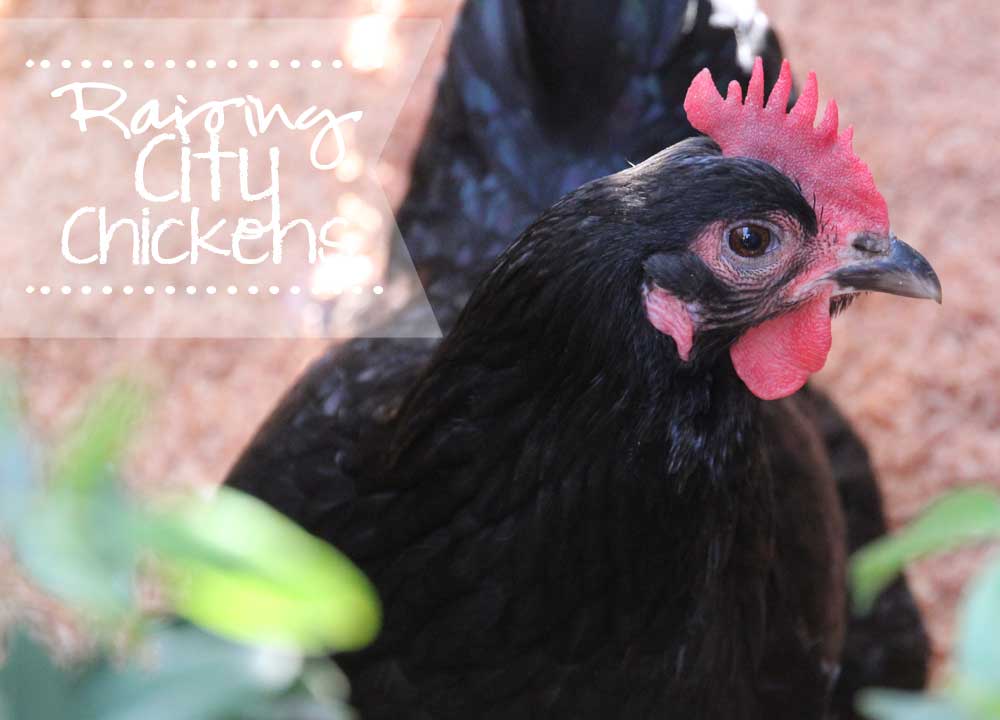
You’ll notice in this post that we have just two lovely ladies left in the mix. Due to an unfortunate mix up early on, we accidentally returned our white hen back to the farm when her frequent ‘cockle-doodle-doo!’ early morning wake up calls had us convinced we ended up with a rooster. Turns out she was really a she and from that day forward we stopped finding white eggs in the hen house. I later learned that it’s not unusual for a female chicken to exhibit a few of the traditional rooster cries and reactions when there’s no rooster around. Sigh.
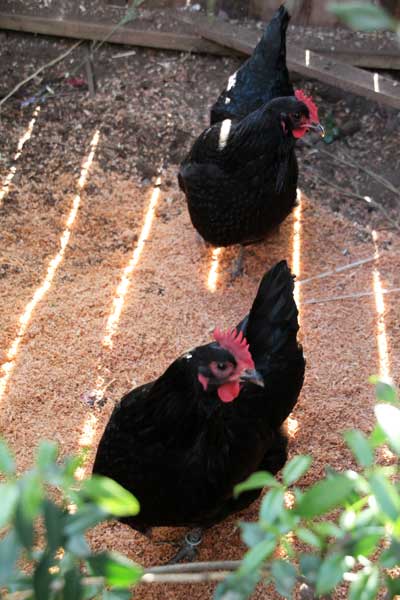
But! Our two other ladies are doing just great. See how much they’ve grown? They joined our family at just 4 months old – almost two years ago.
Between breakfast, hard boiled egg snacks and baking, two hens are actually the ideal for the amount of farm fresh eggs our family eats each week.

Each hen lays maybe 5-6 per week which means that we rarely ever have to purchase eggs from the grocery store or Farmer’s Market. Plus, the eggs are the best you’ve ever had. Rich, dark yellow yolks full of yummy nutrients, thick egg whites perfect for separating out or cooking with, and of course they’re incredibly fresh.
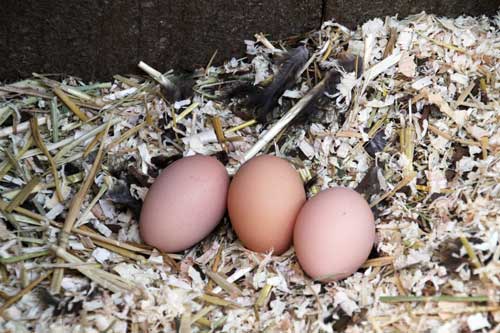
We feed the ladies a mixture of pellets, mash (a corn blend) and kitchen scraps. They devour left over morning oatmeal with raisins (a near everyday treat) and love veggies – especially greens and tomatoes – and fruit. It’s a great way to compost, nothing goes to waste.
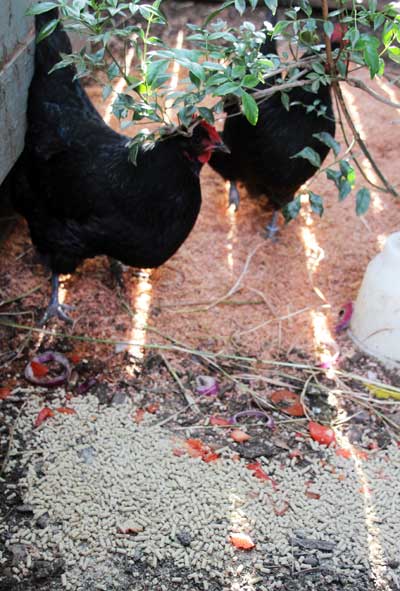
Prior to us finishing the new deck and outdoor dining area, the chickens freely roamed our entire backyard. Gathering up eggs turned into all out Easter egg hunt where one of us would suddenly stumble upon a hidden nest. Here’s an Instagram post from a little while back:
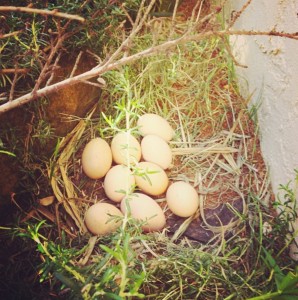
(Don’t worry, fresh eggs can be left outside for weeks before going bad.)
But letting them loose outside had its pros and cons. They had their choice of vegetation and bugs to snack on plus plenty of daily exercise. But they also made a mess. Once the deck went in, back to the coop the ladies went.
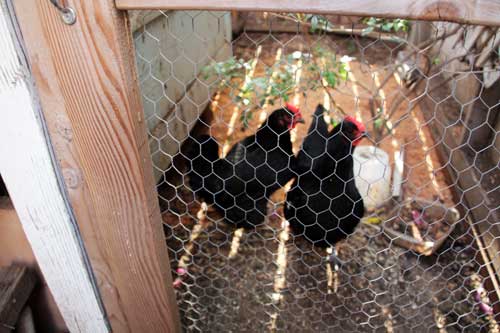
Locked up. Now instead of just sleeping in their home, they enjoy their studio apartment full time. But don’t feel bad for them, their home comes complete with wood shavings for a nicely textured floor, fresh hay and alfafa in their nesting box and a roosting pole that’s quite high for sleeping.
And we still enjoy a nice big bowl of free-range, farm-fresh, naturally grown eggs. If your chickens are really mad at you they’ll stop laying :).
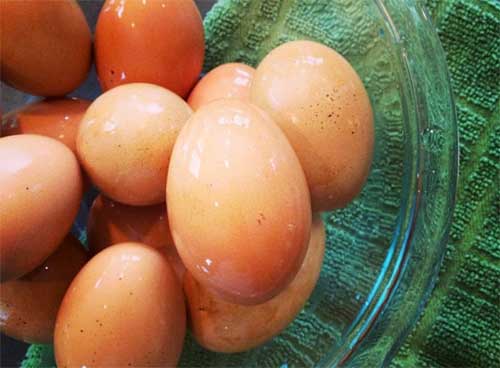
Questions that I’m frequently asked:
1. Where do you find your feed and hay supply? We used to have to source both of these from the outlying San Diego feedshops (the nearest being a half hour from our home). But we recently found out that there are quite a few city farmers in our neighborhood! And now our local pet supply store happily orders and delivers all of the supplies we need.
2. Have you had to deal with rodents or bugs? Yes. Both. We eradicated all of the above within the first few months of the hens moving in and haven’t had an issue since, but it was definitely not fun to learn how to fend off non-feather friendly creatures. Diatomaceous Earth (DE for short) became a product we now know.
3. Do you add any supplements to their food? These ladies receive A LOT of delicious fruit and veggie scraps and I think that has a ton to do with how delicious their eggs are, but after a little research I began adding ground up oyster shells (also from our pet store) to the mix for extra strong egg shells.
4. How much do they cost to raise? Is it worth it? Truth be told, the cost of caring for these ladies is about equal to the price you’d pay for free range eggs at the supermarket. You have to love the idea of caring for and growing your own food to be a full fledged chicken farmer. Or, invest in more than two hens and share the wealth with friends and neighbors. We’ve considered expanding the flock since taking care of two or six is probably about the same amount of work.
5. What’s one thing that really surprised you? We didn’t realize that hens take a break from laying during winter to more permanently roost or brood. The newbies that we are, we couldn’t figure out why the ladies suddenly stopped producing so frequently November – February! Many backyard farmers add heat lamps or lights to extend the daylight that chickens receive during the winter so that they’ll continue to lay, but we’re going au naturale – we all need a break now and then.
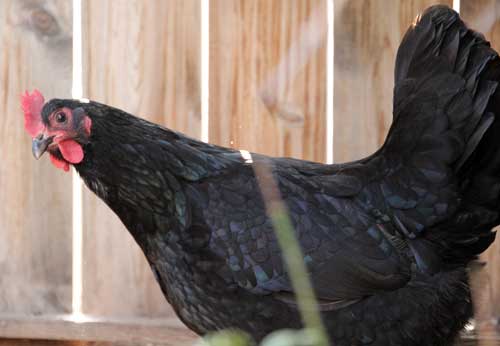
The conclusion? Chickens are a lot of work! and they’re not for everyone. But we love ’em. Our mini city farm will be sticking around for a while.
In honor of Earth Day, here’s a link to all of our Going Green posts (with ideas on worm composting, favorite green household products, cloth diapering, etc).


I was wondering how you managed that gorgeous deck re-do and your chickens! Love the update.
What a great post! We just moved into our first house together in San Diego and we’ve (well, really I’ve) been thinking about chickens! Just collecting info now but it’s helpful to see how other people do it. :)
If you have any questions, happy to help! Though I still consider us newbies ourselves…
Thanks, I’ll keep you in mind! :)